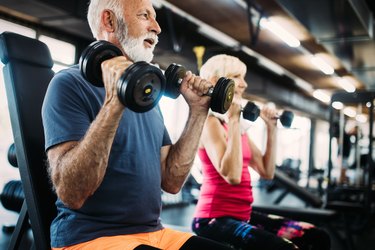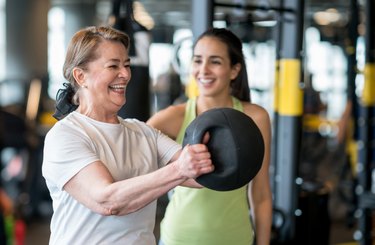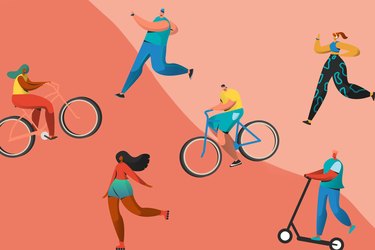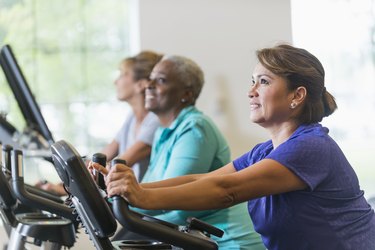
More than one out of three men over age 20 have overweight or obesity, according to statistics published by National Institute of Diabetes and Digestive and Kidney Diseases. If you're in your 30s and you find yourself in this category, it's time to consider prioritizing weight loss, since obesity increases your risk of developing heart disease and type 2 diabetes.
Of course, in order to lose weight, you need to trim calories and move more, but dainty portions of salad and dance aerobics aren't required. Instead, adopt a weight-loss plan that fits your lifestyle and supports your body's needs — here's how.
Video of the Day
Video of the Day
Why Weight Gain Can Occur in Your 30s
Hormone Dips
After age 30, you experience a drop in production of testosterone — a sex hormone — at a rate of approximately 1 percent each year, according to the Mayo Clinic. Healthy testosterone levels help men maintain fat distribution and muscle mass, as well as bone density, body hair, red blood cell production, sex drive and sperm production.
Lower levels of testosterone are linked to increased belly fat, per a May 2015 review in Obesity Reviews. But the good news is that there is evidence of increased testosterone levels with weight loss.
Aging and Calorie Imbalance
The kicker is that around the same time, you start to lose lean tissue and gain considerably more fatty tissue just from aging.
Men ages 22 to 45 gain about 3.4 percent of their body weight every 10 years, according to the American Council on Exercise (ACE). There generally is a decrease in physical activity and calories burned as you get older. And with a decrease in physical activity means a decrease in muscle mass. This loss of muscle reduces your metabolic rate, as your body requires more calories to maintain lean muscle than fat.
So, you're fighting lower testosterone levels plus normal aging factors for a nice double whammy.
How Weight Loss Works
The good news: When males cut calories from their diet, they tend to lose weight faster than females in the beginning because of their naturally greater levels of muscle mass. Remember — the greater the muscle mass, the greater the calorie burn at rest.
The average man, according to the Academy of Nutrition and Dietetics, burns between 2,000 and 3,200 calories a day. Of course, the more active you are, the more calories you burn. You can create a 1,000-calorie deficit by combining diet and exercise, without having to reduce your caloric intake drastically. A pound of fat equals 3,500 calories, so if you hit this 1,000-calorie deficit every day, you could safely lose two pounds a week, per the Mayo Clinic.
Warning
It’s highly recommended that your calorie intake not fall below 1,500 a day for men, unless you’re under the guidance of a medical professional, per Harvard Health Publishing.
Weight-Loss Diet Plan for Men
Did you know that not all calories are created equal? If you want to lose weight and stay healthy it's all about where your calories are coming from and how those calories affect you metabolically, according to Harvard Health Publishing. Follow these strategies:
Opt for a Balanced Diet
A healthy and balanced eating plan is one that allows food from all the food groups, as long as you watch your portions and track your calories. To help manage your weight, though, you'll want to limit your intake of refined carbs, trans fat, added sugars and processed food, according to the Centers for Disease Control and Prevention (CDC).
Choose high-quality, healthful foods like lean meats and fish, fruits and veggies, whole grains and good fats.
Include Plenty of Fiber
Reach for fiber-rich foods whenever possible. Fiber-filled fruits and veggies are fantastic foods for fat loss because they have a higher satiety factor, keeping you fuller longer, according to Jim White, RDN, ACSM EX-Pe.
Aim to get 30 to 38 grams of dietary fiber per day, according to the Mayo Clinic. Some high-fiber foods to try include beans, sweet potatoes and avocados.
Nix the Booze
There are a few reasons to limit the adult beverages. Alcohol contributes to weight gain not only because it has a high energy density (providing 7 kcals per gram), but because it also doesn't provide any real nutrients to your body to use as fuel, White says.
And since drinking alcohol is also a social activity, people may over-consume without realizing the caloric load they're adding. Too many adult beverages can compromise decision-making or stimulate hunger, so you may be more likely to consume unhealthy food while drinking.
Hydrate With Water
Water is not only the best way to hydrate your thirsty body, but it can also aid in weight loss too. Drinking water can help you feel full, which will help you cut back on mindless snacking. It can also aid in getting rid of some excess water weight, according to the National Academy of Sports Medicine (NASM).
Use the Pyramid
You can make it easier on yourself by following the Healthy Eating Pyramid and Healthy Eating Plate, Harvard T.H. Chan's School of Public Health. It's a type of guide — a grocery list, if you will — that will help you choose what types of food to buy and how much to eat at each meal.
At the bottom of the pyramid, you'll find foods that are ideal to frequently consume, such as vegetables, healthy fats and whole grains. Higher up, as the triangle heads to a point and grows more narrow, you'll find foods to consume in moderation followed by foods to eat sparingly, like red meat and butter.
Healthy Diet for a 30-Year-Old Man
The U.S. Department of Agriculture provides a sample meal plan for a 2000-calorie-a-day diet. This is a good place to start if you're a bit stumped — take a look at some sample meals on this healthy diet plan.
For breakfast, this plan includes these options:
- Oatmeal with skim milk, raisins and brown sugar with a cup orange juice
- A breakfast burrito with grape fruit
- Oat cereal with banana and skim milk, whole-wheat toast with margarine and a cup of prune juice
At lunch, you might have:
- A taco salad
- Roast beef sandwich with baked potato wedges with a cup of skim milk
- Tuna salad sandwich with a peach on the side with a cup of skim milk
For dinner, enjoy:
- Spinach lasagna roll-ups with a whole wheat roll
- Baked salmon on beet greens, quinoa with almonds
- Roasted chicken with a sweet potato and succotash
Some snack ideas are:
- Raisins
- Almonds
- Cantaloupe
- Dried apricots
- Yogurt
Exercise Is Key to Losing Weight After 30
Adults should be getting at least 150 to 300 minutes of moderate-intensity or 75 to 150 minutes of vigorous-intensity cardio throughout the week, according the Physical Activity Guidelines for Americans. You should also add strength training in at least two to three times a week.
Strength Training
This may come as a surprise but strength training should be as big a priority as cardio, since it builds muscle mass, which replaces fat and increases metabolic rate, according to ACE.
Your workouts should address all the major muscle groups, per ACE, with functional, multi-joint (compound) exercises. You'll encourage the release of growth hormone to build muscle mass. Having a more muscular body enables you to burn more calories at rest, while also helping to mitigate the loss of testosterone.
A study published in September 2012 in European Journal of Applied Physiology found that men who exercise regularly was linked to higher testosterone levels than men who weren't active at all. Similarly, a study on men with obesity published in the Journal of Clinical Biochemistry and Nutrition showed that regular physical activity increased testosterone levels more than just losing weight.
Ready to dive in? Take a look at this beginner-friendly guide to common types of strength-training, along with tips to get started and six of the best basic moves.
HIIT Workouts
High intensity interval training is the way to go when you're looking to burn the most calories in the least amount of time. This type of workout involves repeated bursts of high intensity activity followed by lower intensity recovery times, according to the American College of Sports Medicine, such as alternating sprinting for 40 seconds with walking for 15 seconds.
A June 2017 article in Obesity Reviews found that short-term HIIT workouts can lead to decent amount of body composition improvements without even losing weight, despite minimal time commitment.
Here's exactly how to build the best HIIT workout for you.
Get Support
Look, if you're just starting out, this can all be pretty daunting. There's no one-size-fits-all when it comes to diet, exercise, losing and maintaining weight and staying fit. The best thing to do is hire a certified personal trainer and see a local registered dietician to get a plan in motion that suits you.
- National Institute of Diabetes and Digestive and Kidney Diseases: "Overweight & Obesity Statistics"
- Mayo Clinic: "Testosterone Therapy: Potential Benefits and Risks As You Age"
- Obesity Review: "Testosterone and Obesity:
- American Council on Exercise: "Is It True That Metabolism Decreases With Age?
- Harvard Health Publishing: "Calorie Counting Made Easy"
- Harvard Health Publishing: "There's No Sugar-Coating It: All Calories Are Not Created Equal
- Centers for Disease Control and Prevention: "Healthy Eating for a Healthy Weight"
- National Academy of Sports Medicine: "How To Lose Water Weight Effectively"
- Harvard T.H. Chan’s School of Public Health: "Healthy Eating Pyramid"
- U.S. Department of Agriculture: "Sample Menus for a 2000-Calorie Food Pattern"
- Physical Activity Guidelines for Americans: "Chp 4: Active Adults"
- American Council on Exercise: "Trimming Off the Fat"
- American Council on Exercise: "5 Benefits of Compound Exercises"
- European Journal of Applied Physiology: "Physically Active Men Show Better Some Parameters and Hormone Values Than Sedentary Men"
- Journal of Clinical Biochemistry and Nutrition: "Increased Physical Activity Has a Greater Effect Than Reduced Energy Intake on Lifestyle Modification-Induced Increases in Testosterone"
- American College of Sports Medicine: "High Intensity Interval Training"https://www.acsm.org/docs/default-source/files-for-resource-library/high-intensity-interval-training.pdf
- Obesity Reviews: "The Effects of High-Intensity Interval Training Vs. Moderate-Intensity Continuous Training on Body Composition in Overweight and Obese Adults: A Systematic Review and Meta-Analysis"
- Mayo Clinic: "Chart of high-fiber foods"




